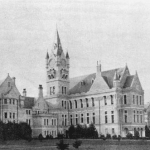 Technology
Technology  Technology
Technology  Humans
Humans 10 Everyday Human Behaviors That Are Actually Survival Instincts
 Animals
Animals 10 Animals That Humiliated and Harmed Historical Leaders
 History
History 10 Most Influential Protests in Modern History
 Creepy
Creepy 10 More Representations of Death from Myth, Legend, and Folktale
 Technology
Technology 10 Scientific Breakthroughs of 2025 That’ll Change Everything
 Our World
Our World 10 Ways Icelandic Culture Makes Other Countries Look Boring
 Misconceptions
Misconceptions 10 Common Misconceptions About the Victorian Era
 Mysteries
Mysteries 10 Strange Unexplained Mysteries of 2025
 Miscellaneous
Miscellaneous 10 of History’s Most Bell-Ringing Finishing Moves
 Technology
Technology Top 10 Everyday Tech Buzzwords That Hide a Darker Past
 Humans
Humans 10 Everyday Human Behaviors That Are Actually Survival Instincts
 Animals
Animals 10 Animals That Humiliated and Harmed Historical Leaders
Who's Behind Listverse?

Jamie Frater
Head Editor
Jamie founded Listverse due to an insatiable desire to share fascinating, obscure, and bizarre facts. He has been a guest speaker on numerous national radio and television stations and is a five time published author.
More About Us History
History 10 Most Influential Protests in Modern History
 Creepy
Creepy 10 More Representations of Death from Myth, Legend, and Folktale
 Technology
Technology 10 Scientific Breakthroughs of 2025 That’ll Change Everything
 Our World
Our World 10 Ways Icelandic Culture Makes Other Countries Look Boring
 Misconceptions
Misconceptions 10 Common Misconceptions About the Victorian Era
 Mysteries
Mysteries 10 Strange Unexplained Mysteries of 2025
 Miscellaneous
Miscellaneous 10 of History’s Most Bell-Ringing Finishing Moves
10 Misconceptions in Food History
Food history is filled with myths and misunderstandings that have persisted for centuries, shaping how we view what we eat today. From the origins of iconic dishes to the cultural significance of certain ingredients, many of the stories we think we know about food are far from the truth.
Here are 10 misconceptions in food history.
Related: 10 Specialty Foods Once Common in America
10 Caesar Salad Isn’t Named for Julius Caesar
As one of the most famous historical figures of all time, it’s no wonder most people just assume the Caesar salad is named for the Roman general and statesman Julius Caesar.
But that assumption discredits Caesar Cardini, the Italian chef who ran a successful upscale restaurant in Tijuana, Mexico. His restaurant was popular in the 1920s because alcohol could be served while Prohibition raged on across the border in America. According to Caesar’s daughter, so many people came to dine that her father had to improvise to keep them busy and made the salad “to give the dinner guests a show as well as a meal.”
The popularity of Caesar’s salad stayed with him when he moved to America, and he spent the rest of his life producing and marketing his famous salad dressing, which he trademarked in 1948.[1]
9 Dom Perignon Did Not Invent Champagne
French Benedictine monk Dom Perignon has long been associated with champagne. While he made vast improvements to the winemaking process, he didn’t actually create the bubbly drink we know and love today. The wine he made was fermented and did have bubbles, but it is not as carbonated as we’re used to.
That wouldn’t happen until the 19th century when a French woman developed a technique to balance the second fermentation process done to white wines from the Champagne region of France. Perignon gets credit because one of the other monks at his abbey, Dom Groussard, exaggerated many stories about Perignon to generate interest in and prestige for the church.[2]
8 Vegetarian Meat Wasn’t Created for Vegetarians
Today, most restaurants have tons of vegetarian and vegan options. There are even entire grocery aisles dedicated to non-meat alternatives. But fake meat like Chick’n and Impossible meat wasn’t made for people hoping to avoid eating animals. It was made to keep people alive.
During World War I, food in Europe was scarce. German inventor Konrad Adenauer had the idea to take the food items they had surpluses of but couldn’t be eaten alone, like corn, barley, and flour, and turn them into “Kolner wurst.”
Apparently, it lived up to the name. The non-meat sausage was dry and had pretty much no flavor, but it did keep the soldiers alive. It’s thanks to Kolner’s weird concoction that we have Beyond Chicken Nuggets and Impossible Burgers.[3]
7 Coca-Cola Was Never Made with Cocaine
While it’s true America’s favorite soft drink did at one point contain coca leaves, the idea that Coke actually contained cocaine is erroneous. Considering John Stith Pemberton created the drink in 1886 as an alternative to alcohol, it would be pretty ironic if his drink got people high.
But there is a sliver of truth to this myth. The Coca-Cola Company estimates that in the early 1890s, a glass of Coke contained an estimated nine milligrams of cocaine drawn from coca leaves, which is the raw material that cocaine comes from. That’s a pretty small amount, considering a typical line of cocaine generally contains 50mg.
Coca leaves also aren’t equivalent to cocaine. After all, coca leaves are perfectly legal and even common in many South American countries—though the U.S. and UK have outlawed them. Thus, the idea that Victorian-era soda drinkers were getting high off their drinks is not true.[4]
6 Hydrox Isn’t a Knock-Off of Oreos
Crossword solvers and cookie lovers both have an affinity for Oreos, the small biscuit sandwich with “crème” in the middle. Whether you eat the creme or cookie first, with or without milk, what you’re really eating is a knock-off of Hydrox.
Contrary to popular belief, the 1908 Hydrox cookie actually precedes Oreos by four years, making the more famous brand the copycat. Oreos simply become more popular despite having nearly the same recipe. Most people attribute this to Hydrox’s name, which sounds more like a cleaning product than a delicious snack. After a few decades of rigorous “biscuit wars,” Oreo eventually came out on top in the 1950s as the ubiquitous cookie.[5]
5 The Croissant Isn’t from France
Baguettes, ratatouille, and croissants are some of the most famous foods you have to try in France. But one of these is not actually native to the country.
Arguably the food most associated with France, the croissant actually originated in Austria. They called these light, layered pastries “kipferl,” and they weren’t all that popular until 1683. That’s when the Habsburgs defeated the Ottoman Empire at the Battle of Vienna. To celebrate, Viennese bakers started shaping their kipkerl like the crescent moon on the Ottoman flag.
It wasn’t until the 19th century that Austrian bakers began to migrate to France and, unsurprisingly, not Turkey.[6]
4 Marco Polo Didn’t Introduce Pasta to Italy
Pasta-like food has been around for centuries, beginning with the Chinese. So it makes sense that many think Italian adventurer Marco Polo was the one to introduce pasta to his home country. His travels to Asia and historical fame make it seem only natural. But it’s probably not true.
Polo did describe eating long, noodle-like food while in China, which may have helped promote the prevailing theory. However, archaeological evidence shows that pasta-making dates back to ancient civilizations, including the Etruscans and Romans, who resided in Italy.[7]
3 George Washington Carver Didn’t Invent Peanut Butter
It feels slanderous to say that American agricultural scientist George Washington Carver was not the first one to bring us the delicious invention of peanut butter, but it’s true. And it’s easy to see where this misconception comes from.
Carver discovered hundreds of uses for peanuts, including non-edible concoctions like shampoo, glue, and insecticides. While his promotion of the health and nutrition benefits of the peanut did help make it a staple of American households, it was actually John Harvey Kellogg, of cereal fame, who patented peanut butter in 1895. Even before that, historians have found crude recipes for peanut paste and butter-like substances going back to 950 BC.
Even though he’s not the one who actually created the ingredient that can be found in 94% of American households, there’s no doubt Carver’s research on the many uses of the peanut helped popularize it.[8]
2 Fortune Cookies Are Not Eaten in China
No Chinese takeout meal would be complete without a broken fortune cookie at the bottom of the bag. Even though these desserts don’t actually come from China, they are pretty exotic, hailing from Japan.
So, how did most of the Western world come to associate them with China? In the early 1900s, Japanese immigrants flooded Hawaii and California after Chinese workers were forced out by the Chinese Exclusion Act. They brought with them miso and sesame-flavored crackers and cookies, as well as other traditional foods such as sushi.
But Americans weren’t so open to new cuisines. Trying to distance themselves from the image of raw fish, which was generally unpopular, many Japanese business owners actually opened Chinese restaurants, as chop suey and chow mein were popular at the time. After Pearl Harbor, Americans were less eager to patronize Japanese businesses, giving Chinese immigrants the chance to reclaim their food and the new expectation of a treat with the check.[9]
1 The Earl of Sandwich Didn’t Invent the Sandwich
Though it’s a great story, an 18th-century nobleman is not the creator of the sandwich. Popular legend has it that John Montagu, the fourth Earl of Sandwich, not wishing to interrupt his gambling session for lunch, asked for his food to be tucked between two pieces of bread.
While this might be true, it’s definitely not the first time in history it’s happened. We know that eating food between bread goes as far back as the first century BC, as the Jewish text the Haggadah recounts how Hillel the Elder made sandwiches of lamb and matzoh bread.
We’ve come to associate it with Montagu thanks to an 18th-century writer who published a gossip and travel book with the aforementioned gambling tale. Though he doesn’t say which noble, people assumed it was the Earl of Sandwich, and the name stuck.[10]








